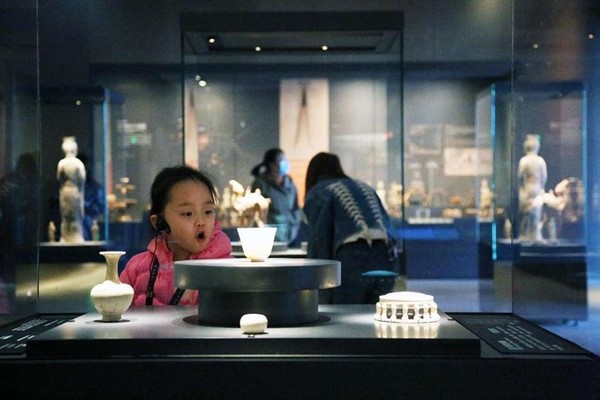By Gong Shijian, Zhang Danhua, People's Daily
Shaanxi province in northwest China enjoys a long history and rich cultural heritage. In recent years, Shaanxi has made great efforts to promote cultural inheritance through strengthening cultural heritage preservation, leveraging technology, and facilitating cultural exchanges.
This allows Shaanxi's profound history and traditions to harmoniously coexist with openness, inclusiveness and modernity.
The Shaanxi Archaeology Museum, with its Tang Dynasty (618-907) styled architectures and garden-like layout, is drawing crowds of archaeology enthusiasts from near and far, exuding grandeur and grace.

"The construction of this archaeology-themed museum took 10 years. It exhibits over 5,000 cultural relics, with each carrying the genes and codes of civilization, as well as the wisdom of ancient people. They are priceless treasures," said Sun Zhouyong, curator of the museum and head of the Shaanxi Academy of Archaeology.
Improving its capability in museum construction, Shaanxi province has taken huge efforts to protect historical and cultural relics.

Shaanxi province has over 350 museums, averaging one museum for every 100,000 residents, far exceeding the national average. These institutions have become vital windows into the province's achievements in cultural relics preservation.
In the province, people can seek the earliest bronze ware engraved with Chinese characters "zhong guo," which means China, at the Baoji Bronze Ware Museum. They can also see how relics are unearthed and repaired at the Emperor Qinshihuang's Mausoleum Site Museum, and catch a glimpse the splendor of the Tang dynasty at the Shaanxi History Museum.

Shaanxi province attaches high importance to archaeological studies along the Silk Road. It is constantly enhancing its archaeological capability and discipline construction.
Professor Wang Jianxin of Shaanxi's Northwest University, who is the first Chinese scholar to conduct archaeological investigation in Central Asia, finally unearthed the remains of the Yuezhi Culture and the Kangju Kingdom recorded in the Records of the Historian and the Book of Han after more than 20 years of efforts, making important contributions to archaeological studies along the Silk Road.
Chinese scholars, represented by archaeologists from the Shaanxi Academy of Archaeology, the Northwest University and other institutions have established profound friendship with their counterparts in Kazakhstan and Uzbekistan during joint archaeological investigations, sharing with the latter the Chinese experiences of protecting and studying major heritage sites accumulated this century.
Shaanxi, which houses over 110 universities and more than 1,500 scientific research institutions, boasts formidable strength in scientific research. Its innovation capability, driven by a huge talent base, is breathing new life into its cultural riches - from heritage sites standing on the vast land, to scripts penned in ancient texts, and to treasures collected by museums.
Datang Everbright City scenic area, a tourist landmark of Xi'an, Shaanxi province featuring a grand street with characteristics of the Tang Dynasty, launched an augmented reality (AR) project this year, which enables tourists to see virtual objects in the real-world environment and thus offers them an immersive experience.
Wearing a pair of AR goggles, tourists will be able to see carps leaping into the sky, blossoming fireworks, the magnificent Hanyuan Hall of the Daming Palace, the route of Tang Dynasty Buddhist monk Xuanzang's journey to the west, etc.
At the Xi'an Museum, information about over 100,000 ancient books in its collection has been digitized and recorded in virtual space, including details on authors, graphic designs and copyrights. Visitors to the Shaanxi History Museum can easily view every intricate detail of the museum's Tang Dynasty murals on their phones by simply scanning a QR code, thanks to the implementation of high-resolution image capture and virtual display technologies.
So far, digitalization is being widely promoted at general museums, libraries, local chronicles museums, archives, galleries and cultural centers in Shaanxi province.
The China (Shaanxi) Pilot Free Trade Zone, which was established seven years ago, has accelerated the development of the province's cultural services and trade, and facilitated the mutual understanding and recognition among different cultures.
A series of cultural performances as well as art and cultural festivals of Shaanxi province have been staged overseas, bringing local intangible cultural heritage items to foreign audiences, including the Hancheng drum, Ansai folk paper-cutting, Chinese New Year wood painting, opera masks and shadow play. They have fully demonstrated the unique charm of the Chinese culture.
Besides, Shaanxi's capital city Xi'an has held the Silk Road International Arts Festival attracting artists from over 100 countries and regions, as well as the Silk Road International Film Festival that gathers global directors, writers and actors and discusses the innovation and mutual learning in the sphere of the film industry.

